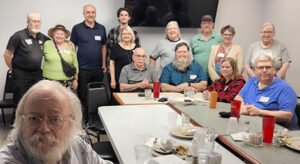
Linda in Northfield, Mensagenda Editor
About Mensagenda
Minnesota Mensa published Vol. I, No. 1 of our newsletter, then called the Minnesota Mensa, in June of 1965. Approaching six decades later and winning awards along the way, we continue to provide a monthly publication, now called Mensagenda.
As expected in a newsletter, we inform our local membership with organizational updates and provide details about our events. The real benefit is that, just like our events, Mensagenda is for our members, by our members.
The love of learning in Mensa is not just about supporting our scholarship but in enriching your own mind and sharing your knowledge, skills, and interests. Read articles and regular columns ranging from scientific explanations to humor in everyday life. Check out our members’ photography, drawing, painting, knitting and quilting, and crafting skills.
What would you like to share? Do you have expertise in a particular field of study or hobby? Want to express your opinion? Have you traveled recently? Do you write poetry? Can you create word games, numerical puzzles, or trivia questions? What could you say about…well, you get the picture.
Mensagenda is another way that Minnesota Mensa provides “a stimulating intellectual and social environment for its members.” What could you contribute if you joined Mensa?
There’s More to Read
Mensa membership provides access to the publications from other chapters, American Mensa, and Mensa International. Click here to learn more.
Featured Cover Art

Photo taken at First Friday in June.
Hoard of Babylon, Part II
by Cheryl in Roseville
Dad would want you to know Mom actually died 18 years and 11 months ago. For brevity’s sake, I’m saying 20 years. That we’d quibble over such a difference in calendar dates and that I would do the arithmetic should give you a taste of the dysfunctional flavor of my family.
Anyway, in April, The Beloved and I flew into town to load a dumpster with two decades’ (+/– 6.5%) worth of life’s detritus. The emotional stress was high, but not for the reasons one might expect.
Dad is not a “stuff” kind of guy. He attaches little sentiment to material objects. The only exception is his imbuing paperwork with too much “just in case” importance. My father worked for the government for decades. I now think he was recruited less for his SATs and more for his OCD CYA scores.
Sister and I got a little bogged down not in the sentiment attached to objects but more in their impermanence. If we pitched some bit of 1970s tat, it wasn’t just a macramé owl disappearing but a tiny bit of our mother. It’s an odd thing for us to worry about. Throughout our lives, Sister and I have often threatened each other with imminent impermanence. We didn’t worry then about losing something Mom had made, only getting caught. “Honestly, Mom, I have no idea how the baton got lodged in her frontal lobe … .”
Sister’s Achilles heel was anything “still good.” We kept pieces of exotic wood, medical equipment, and camping gear at her insistence. I did see her point; people could use these things. If I’d spent a month in Kentucky, I would have Recycled and rehomed a lot of it. But I had three days and one motto (“Done is better than perfect”) to work with. Dad was no help. He stopped my pitching a pitchfork (ironically). “Whoa, your sister might want that.”
“I am solving this problem, not moving it 20 miles north,” I replied.
And that was where my own emotional difficulty lay. My latent engineer whimpered and twitched in frustration in the back of my skull.
When the TO DONATE pile threatened to topple and cause structural damage, I suggested we load up the car for a run to Goodwill. I was told, “Oh, we can arrange for them to pick it up.”
They’ve had 20 years to do so. And haven’t.
I offered to take the sensitive paperwork to UPS for shredding. Nope, they said, that would cost a dollar a pound and the city offered free shredding days every now and then.
Really? How many such days have there been in the last 6,000?
The Beloved and I found a Pringles can full of coins. We offered to take those down to the sorting machine at the 24-hour mega mart. What?!? Those contraptions charge a percentage! Sister could roll a lot of coins for free, she said. Dad said his bank would take them unsorted.
Never mind that the most predatory fee from a sorting machine is less than the money he has lost in 224 months of compound interest.
When Dad left, he forgot the coins. Again. The Beloved and I said, “Screw it,” cashed them in at the store, and treated ourselves to a meal. The real ripoff in this story turns out to be the price of pasta in the sticks. We could have shredded reams of paper for the price of fettuccine.
Aside from The Beloved, my only ally in this mission was the owner of the dumpster company. I’d Googled “dumpster rentals” in Dad’s ZIP code and run the first few hits by the Better Business Bureau. Of the remaining companies, I called the one sporting the worst pun. (My straightforward thought process often takes whimsical exits.) Ms. Simon has seen a lot, judging by the specific points on the rental agreement.
No concrete, wet or dry, and no “biological waste.” (Some wannabe gangster is renting?) No toxic or flammable chemicals. Gas grills could go in the dumpster, but absolutely no propane tanks.
“People are throwing away explosives?” I asked, stunned.
“You’d be surprised,” she said. “I had one lady ask if she could set a fire in our container. I’m not sure if she understood ‘dumpster fire’ is meant to be a metaphor. We told her no.”
I felt seen. I hired Ms. Simon’s company. After all, they’d Bin There, Dump That.
©2025 Cheryl Laurent